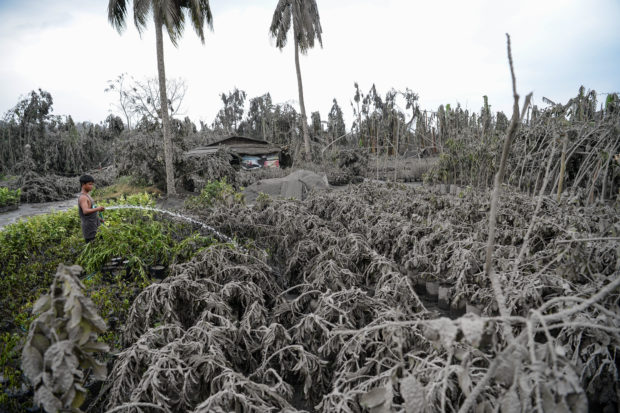P74.5-M crops, livestock damaged by Taal eruption

MANILA, Philippines — Coffee farms in the province of Batangas and Cavite were covered in blankets of embers and mud amid the unexpected blast of Taal Volcano in Batangas province, leaving its residents with millions of pesos in damages and losses.
The Department of Agriculture (DA) released its initial agricultural damage report on Monday evening valued at P74.5 million. Of that number, 99 percent were incurred by the coffee industry, while the rest were recorded in livestock and corn.
“Coffee beans, if they haven’t matured enough, could not withstand that amount of ashfall. The sulfur content already clung to the plants,” Agriculture planning division chief Christopher Morales said.
In Cavite, the municipalities of Silang and Magallanes were hit hard. The city of Lipa and the municipality of Mataas na Kahoy in Batangas were also affected.
Both provinces are considered as the country’s major coffee producers, and both became the country’s coffee capital at one point.
Around 752.45 hectares of lands dedicated to the crop were devastated, resulting in the loss of some 3,563 metric tons of coffee.
The climatic conditions in these two provinces as well as the quality of the soil have birthed the famous Liberica coffee variant known as “kapeng barako.”
Meanwhile, damaged livestock and corn crops were valued at P65,000 and P528,300, respectively.
Socioeconomic Planning Secretary Ernesto Pernia said the preliminary assessment of the Taal Volcano’s eruption’s impact to the economy was estimated to reach P7.63 billion in Batangas alone, excluding public and private damage costs.
The value of the agricultural damage brought by the Taal Volcano already increased to P577.39 million, affecting 2,772 hectares and 1,967 animal heads. Other affected commodities include rice, cacao, banana, and high-value crops.
A total of P21.7 million worth of combined interventions for crops and livestock are set to be distributed to 17 local government units in the region of Calabarzon (Cavite, Laguna, Batangas, Rizal, Quezon).
The Bureau of Animal Industry also has available drugs and biologics to livestock animals affected by the eruption. Two trucks were made available to mobilize the affected areas for animal rescue and evacuation.
The Bureau of Plant Industry will be distributing 5,000 coffee mother plants and 1,000 cacao seedlings.
The Bureau of Fisheries and Aquatic Resources (BFAR) has begun its assessment of the fisheries sector on Tuesday, but it has already predicted that some 6,000 fish cages are at risk of being damaged including the endemic sardinella tawilis and black carp (tilapia).
Residents near Taal Lake have already evacuated and left their livelihoods at the mercy of the volcano, leaving fish cages unattended.
“There are surely fish kills already because of the high sulfur content,” BFAR director Eduardo Gongona said in a phone interview with the Inquirer. “We’ll be going there to take care of the situation especially those fish that were abandoned in fish cages. Someone has to dispose those or the contamination of the water would worsen.”